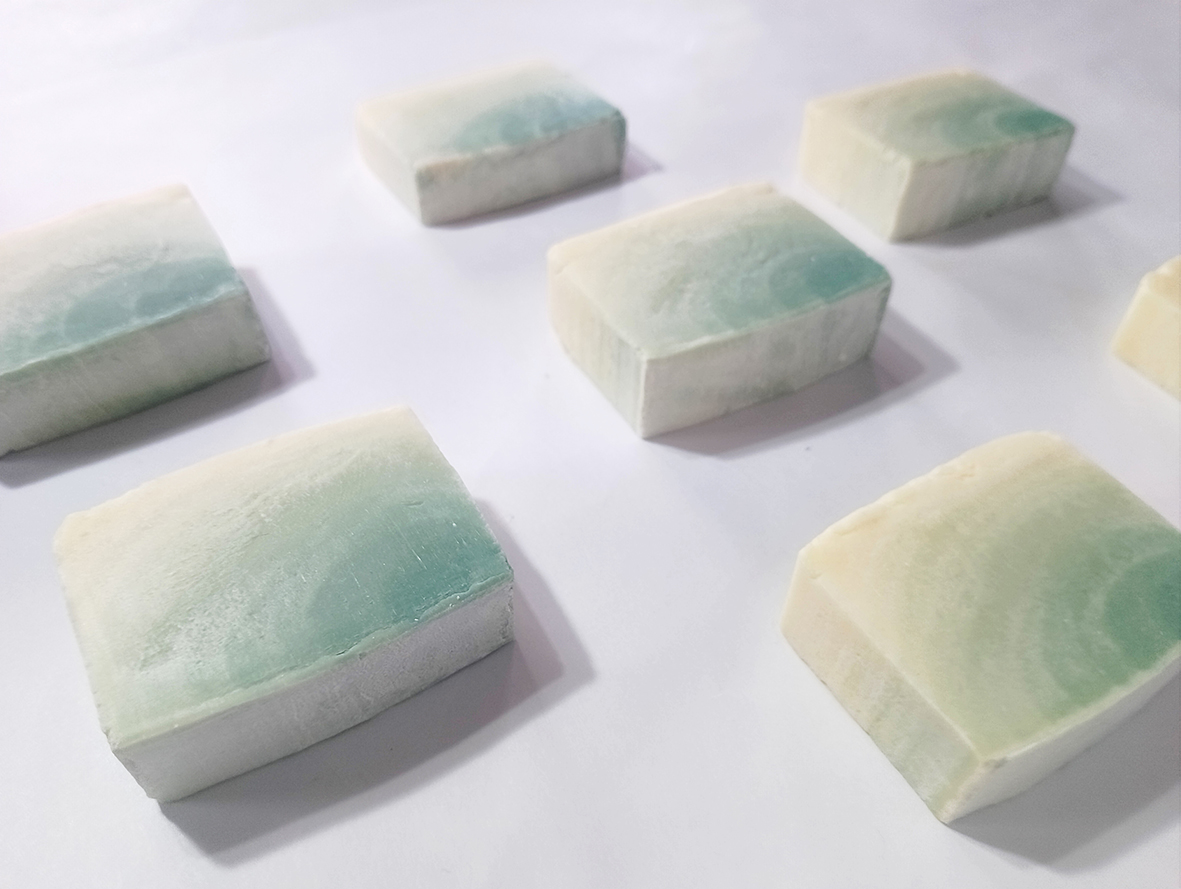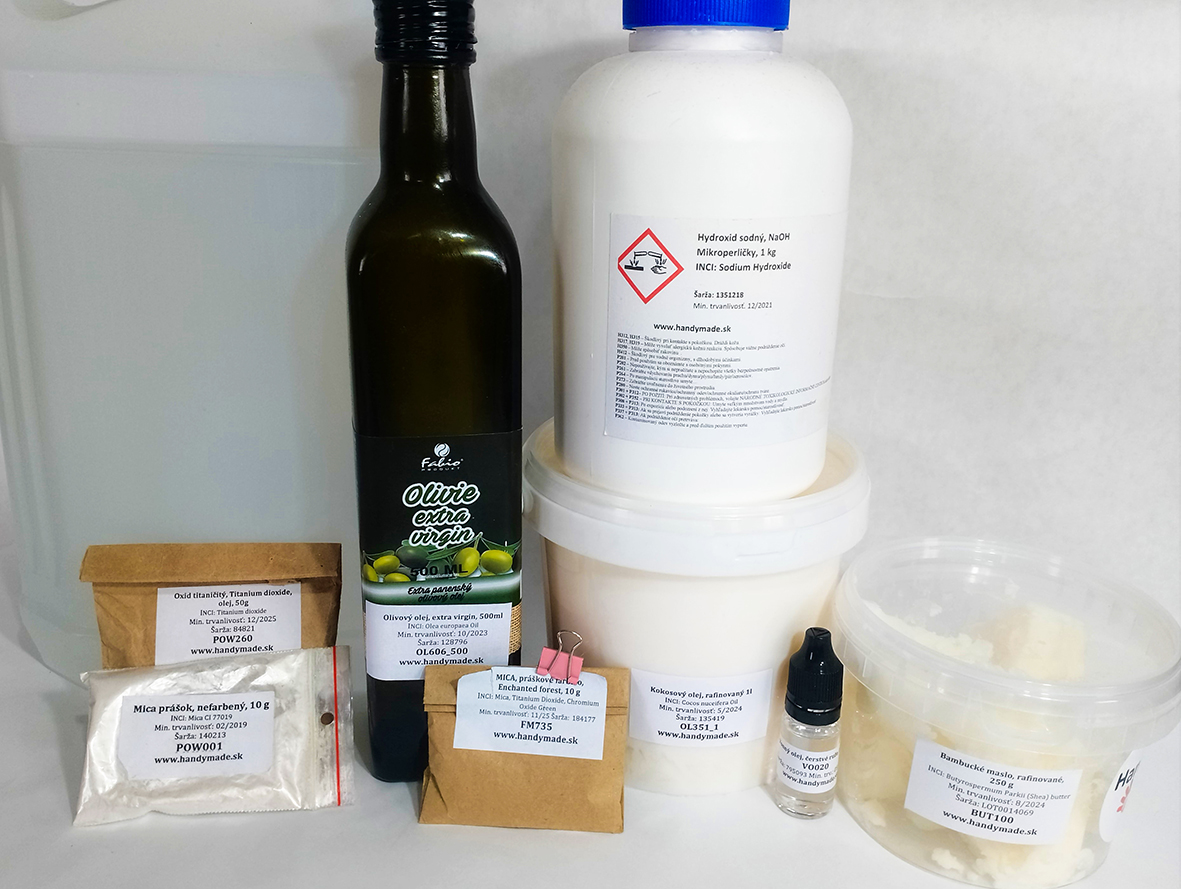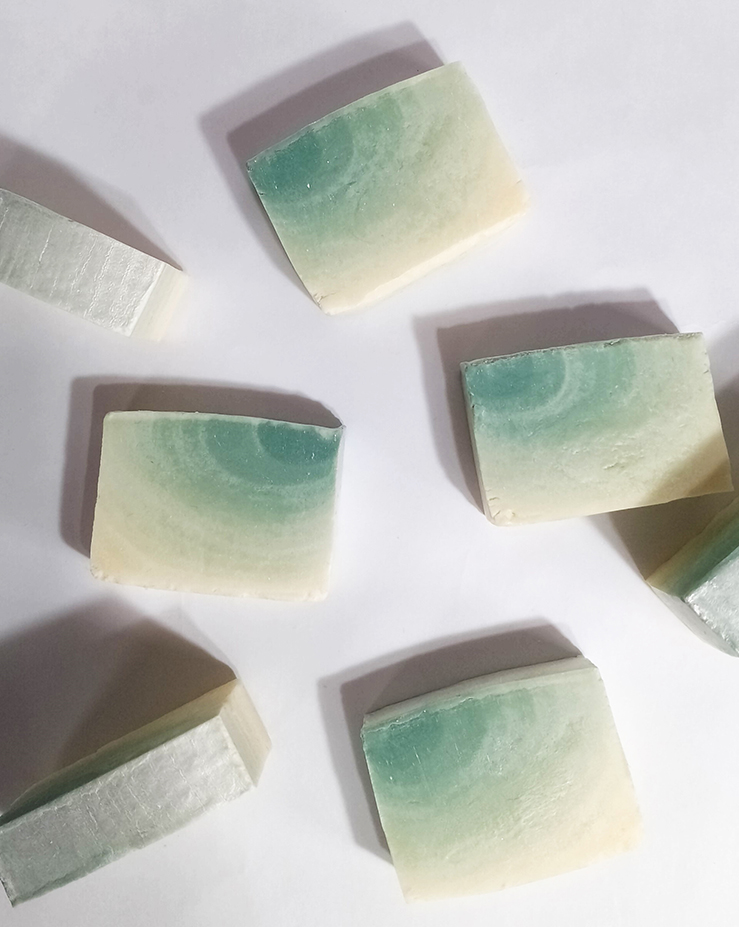Green ombré soap
You can also make green ombré soap from natural ingredients at home. Come with us.
Here's how to make ombré soap using the cold process, i.e. using sodium hydroxide and a combination of oils and butters. Just have an ideal rectangular silicone mould to hand
and you're ready to go!

GREEN OMBRÉ SOAP - INGREDIENTS
A mixture of vegetable oils and butters in combination with an aqueous solution of sodium hydroxide was used to make green ombré soap. The mixture has been coloured with mica powder, but the colour you choose is up to you.
The top of the soap was coated with more white glitter mica powder after it had set - but this is an optional decoration.
Since any substitution of oil or butter in the recipe results in the need to recalculate it (for example, using soap calculators freely available online), the recipe is expressed in grams. At the same time, the total weight of the oils and butters(200 g) includes a 5% fat content (i.e. the oils are in 5% excess to the hydroxide, and so this part of them will remain unreacted and provide care to the skin when using the soap).
INGREDIENCE m (g)
Demineralised water 113,00
Sodium hydroxide 56,00
Olive oil 200,00
Coconut oil refined 120,00
Shea butter refined 80,00
Mica powder Enchanted forest 1,00
Titanium dioxide oil 2,50
English Rose Fragrance Oil 6,00
Isopropyl alcohol - IPA As required
Mica powder colourless As required

GREEN OMBRÉ SOAP - PROCEDURE
1. put on protective equipment - gloves, goggles, long sleeved clothing. Work in a well-ventilated room with plastic, stainless steel containers or cooking/chemical glass.
2. weigh the necessary demineralised water. Weigh the sodium hydroxide into a second container . Stir the hydroxide into the water in small batches. Caution, the mixture will heat up intensively!
Once the hydroxide has been stirred , allow the mixture to cool to 36-38 °C.
3. weigh the butters and oils into a heat-resistant container. Start heating slowly until the butters have melted. Stir well and allow to cool to 36-38 °C. Take about 2 tablespoons, mix one thoroughly with the titanium dioxide and the other with the mica powder.
4.once both the hydroxide solution and the oil mixture have reached approximately the same temperature (36-38 °C), pour the hydroxide solution into the oils. Stir and add the fragrance oil. Then (through a sieve) add the titanium dioxide oil mixture, mix well.
5. stir the mixture a few times with a stick blender (the soap mixture must be fluid enough to pour, not pudding-like, but the oils must not separate from the hydroxide).
6. take about 25 g of the mixture alongside and add the oil solution of the mica powder to it. Mix well.
7. pour about 15-20 g of the unstained mixture into a smaller container (or use a ladle).place the mould on a tray, support the longer edge of the mould with a book or similar object and pour the mixture (15-20 g of the unstained 15-20 g) evenly over the opposite side of the mould from the support.
8. add a small teaspoon of the green coloured mixture to the remaining uncoloured soap mass. Mix well. Pour off about 15-20 g (always keep the same amount) and pour this mixture evenly over the unlined edge of the mould again.
9.continue in this way until you have used up all the originally uncoloured soap mass, to which the green soap mass has been gradually added a teaspoon at a time.
10.at the end, spray the surface of the soap with IPA and carefully pull the book from under the edge of the mould. Cover the mould with cellophane and wrap in a blanket. Carefully lift the tray with the mould and transfer it to a warm place
(under the radiator).
11. after about 1-2 weeks, the soap is ready to cut and you can coat the top with colourless/white mica powder. If the soap is still soft, let it sit for another week.
12.allow the soap to age for at least 6-8 weeks before using. Check the pH of the soap by rubbing the soap with distilled water and then attaching litmus paper. the pH should be between 9-10.
Soap with a higher pH or uneven pH is not safe to use.
GREEN OMBRÉ SOAP - TIPS AND TRICKS
Want to make making green ombré soap easier? You've come to the right place. We'll give you a few pointers
and tips on how to make cold process ombré soap.
Sodium hydroxide is a strong base, so always use protective equipment when working with it. Remember to work in a well-ventilated room, away from pets and children. If skin is affected, always rinse the area thoroughly under a stream of cold water, or you can use diluted vinegar afterwards to neutralise any residual hydroxide. You can also use diluted vinegar for final cleaning of surfaces, immersing all equipment in the solution for a few minutes.any utensils that have come into contact with the hydroxide or uncured soap, then wash them as usual.
When the hydroxide dissolves, a large amount of heat is released, so you can replace about half of the demineralised water with ice also from this type of water. Do not use ordinary tap or boiled water - such water still contains minerals that will interfere with soap formation.
Pour the hydroxide solution and also the dye oil solutions ideally through a sieve. This will prevent the undissolved hydroxide granules from penetrating the soap, but also the formation of lumps of undissolved dye.
When working with liquid soap, it is a good idea to proceed quickly, as the soap will thicken and harden on its own over time. It is important to maintain the same weight of soap for each layer. Therefore, use scales or a scoop to ensure that each coloured layer is the same thickness and that you get the desired ombré effect.
You can also use phenolphthalein solution or papers containing phenolphthalein to check the pH of the green ombré soap. When using phenolphthalein papers, follow the same procedure as with litmus papers, the papers should not turn pink. If you use a solution, drop it on different parts of the soap, it should not turn pink in the same way. A pink color indicates high pH values and thus unreacted hydroxide, such homemade soap is not safe to use.

GREEN OMBRÉ SOAP - RAW MATERIALS
Below you will find more information on the raw materials used, including their properties or how to substitute these raw materials.
DEMINERALISED WATER
Always use distilled or demineralised water to make soaps. We have already mentioned that the minerals
in ordinary tap water cause undesirable reactions with sodium hydroxide, so avoid such water. This is because your soap may not solidify properly and reach a safe pH.
SODIUM HYDROXIDE
Without sodium hydroxide, the saponification process will not take place and you will not prepare solid soap cubes.
Therefore, if you respect the use of this raw material, reach for ready-made soap masses, for example, and prepare your soaps from them. Do not change the weight of sodium hydroxide - it is tied to the amount and type of oils used. Handle it with care, it is a strong principle.
OIL OIL
Olive oil is the basis for making many types of soaps. It provides mild and nourishing soaps,
however, soaps with a high content can be softer and slightly slimy when used, so it is often combined with butters or coconut oil for optimum hardness and soap properties.
Olive oil can be substituted for another vegetable oil in a recipe, but such a recipe must be recalculated on a soap calculator as the amount of hydroxide and water needed will change. The same applies when substituting other oils and butters.
COCONUT OIL
Another popular oil in soap making is coconut oil. This oil provides beautifully hard and foaming soaps. This is also why it combines very well with liquid vegetable oils. You can also reach for the refined version if you are looking for ways to reduce the price of raw materials, as the reaction with sodium hydroxide will be the same regardless of the refined or unrefined version of the oil.
BAMBUCK BUTTER
Shea butter is what gives your soap its creamy lather and nourishing properties. In addition, it will give your soap a partial hardness (compared to olive oil). Thanks to the fat content, the unreacted portion of shea butter will moisturise the skin wonderfully.
MICA POWDER
Mica powders have been used to colour the soap. Mica powders are available in a wide variety of colors,
so choose your favourite one. The added advantage of mica powders is that they are well stable
even in alkaline environments and so do not change colour. It is advisable to mix them in a little oil before adding
and add it through a sieve - this will prevent lumps of unmixed dye from forming.
FRAGRANCE OILS
Fragrance oil was used to perfume the final product. These oils have the advantage of not having an intense colour and so will not interfere with the ombré effect of the soap. It is therefore advisable in this case to avoid dark essential oils, which, although they are an alternativeto fragrance oils, but some of them are intensely coloured and may also colour the resulting soap.
However, it is also possible to omit fragrance or essential oils altogether. These substances are added in relatively high quantities as some of them react with sodium hydroxide, so an excess is necessary.
TITANIUM DIOXIDE
Titanium dioxide is a strong white substance which is used in the manufacture of soaps to lighten them and thus reduce the consumption of other colouring agents. It is advisable to select the type of titanium dioxide for use in oil and to mix this substance well in a small amount of oil before adding it to the soap (ideally through a sieve). You can also omit the titanium dioxide, but then you need to increase the dose of green mica powder by about 0.5 g.
ISOPROPYL ALCOHOL - IPA
IPA is a great helper not only in the production of soaps from soap masses, but also with the cold process technique. It helps to prevent soap dust - a white coating on soap that is mainly an aesthetic defect. You can also spray individual cuts with IPA when cutting the soap to stop the soap from sticking and becoming covered in soap dust.
NOTICE
As mentioned, you can experiment with homemade recipes to achieve desired properties. However, many factors such as humidity, temperature, quality of ingredients and storage can affect the final result.
Before using any raw material to make a cosmetic product, familiarize yourself with its properties, recommended dosage, storage conditions or safe handling. Any raw material may have the potential to cause an allergic reaction in sensitive individuals, so before using a product, we recommend that you find out if you suffer from an allergy to any of the raw materials or the overall product, e.g. by a skin test.
If you have very sensitive or very acne-prone skin, or other skin and health problems, we recommend that you consult a medical professionalbefore applying a new product to your skin, whether it is a homemade cosmetic product, a pure raw material or a commercially available product.
GREEN OMBRÉ SOAP - CONCLUSION
With green ombré soap, just like with the pink soap from the previous post, you'll bring a little color to your bathroom. In addition, you can constantly enjoy the natural composition of these soaps.
Have you tried making green ombré soap? Let us know how you did. Your questions, insights
email us at marketing@handymade.sk and we can exchange knowledge. We look forward to hearing from you.
We sincerely thank our dear Ivana Jačalová for her great posts with instructions like this one on making green ombré soap.
Until the soaping, my friends.


